Composting Waste - Recommendations for Forming a Compost Pile
Every gardener sooner or later faces the problem of improving the quality of the soil in his area. Even fertile soil with excellent characteristics begins to deplete over time. One way to restore soil quality is to use compost.
Content:
Description and advantages of the method
Composting waste is a way of converting organic products with the help of microorganisms into a mixture that can be used in growing plants.
Composting naturally turns garden waste into a useful product that can be used to improve the quality of the soil.
In the composting process, organisms (bacteria, worms, fungi, insects) in the ground and household organic waste, feeding on them and each other, process materials. Bacteria are found in almost all organic matter, and it is they who produce the primary destruction of waste. Mushrooms convert waste into carbon dioxide. Worms and insects consume fungi, microorganisms and waste.
Benefits of composting:
- Saturation of the soil with useful substances.
- Reducing the need for fertilizers.
- Improving soil air permeability.
- Compost retains moisture in the soil, therefore, the amount of irrigation is reduced.
- The possibility of using compost as mulching material.
- Getting free environmentally friendly fertilizers.
- The microorganisms that live in the compost inhibit the growth of pathogenic bacteria, protecting the plant from diseases.
- Disposal of household waste.
- Due to its high humus content, the compost attracts earthworms and insects that loosen the soil.
- In the composting process, due to a natural increase in temperature to 50-60 degrees (with an industrial method, even up to 85 degrees), all pathogenic microorganisms, larvae die pests and seeds weeds.
Composting can be done in two ways:
- Anaerobic - without oxygen.
- Aerobic - with the participation of oxygen.
With the anaerobic composting method, the transformation of waste occurs for a rather long time from 6 to 14 months or more. Therefore, it is better to use the aerobic method and get a healthy product in 2 - 4 months.
In addition, with aerobic composting, the risk of plant intoxication with the resulting mixture is practically zero. An important point will be the absence of an unpleasant odor that accompanies anaerobic composting.
Composting materials
Organic materials suitable for composting are conventionally divided into two groups:
- Nitrogen (green)
- Carbonaceous (brown).
When composting, the layers of nitrogen and carbonaceous materials must be alternated.
The nitrogen components include:
- Cut grass
- Vegetable and fruit waste
- Weeds (without seeds)
- Food waste
- Cuttings (shredded)
- Flowers
- Leaves comfrey
- Seaweed
- Chicken droppings (as an activator)
- Animal dung
- Welding
- Coffee grounds
You can use as carbon components:
- Leaves (rotted, dry)
- Wood scraps
- Shrub branches
- Hay
- Straw
- Wood ash
- Needles (increases soil acidity, use sparingly)
- Wood ash
- Newspapers, paper (excluding glossy magazines)
- Natural fiber fabrics
- Wood chips
- Sawdust
Eggshells can be added to the compost, it is considered a neutral component, and soil, which dampens odors and, thanks to the microorganisms contained in it, speeds up the composting process.
It is not recommended to use as compost components:
- Meat, fish waste or bones - these attract flies and rodents (or use only when composting in closed containers).
- Various fats and oils.
- Egg yolks.
- Milk products.
- Coal ash.
- Perennial Weeds - Can be spread with compost.
- Banana, peach and orange peels are likely to contain pesticides.
- Domestic animal feces.
- Sick plants.
- Black walnut leaves - the juglone they contain is toxic to plants.
Meat and fish waste significantly increases the amount of nutrients in the compost. But they can only be used if the waste is placed in closed plastic containers that rodents cannot enter.
Composting procedure
DIY composting: tips and tricks:
- For compost production, choose a shaded area, preferably located at least half a meter from the buildings and with free access to it.
- Bins, trenches, compost heaps or pits can be used to compost waste. The box can be purchased at the store or made by yourself.
- To obtain a good mixture, you need to mix nitrogen and carbon waste in equal proportions: the optimal combination will be freshly cut grass and brown autumn leaves. If it is not immediately possible to create the optimal proportion, you can adjust the mixture during the composting process.
- Make the lowest layer of large brown twigs or wood shavings to ensure good drainage and ventilation. For the same purpose, branches are recommended to be laid between layers. After that, alternate nitrogen and carbon waste in layers of 10-15 centimeters. You can put soil or mature compost between them. Above the pile must be covered with earth.
- The height of the heap is from one and a half to two meters in height and about one and a half meters in width, any length. It is not recommended to make the compost heap higher and wider, since at large sizes it will be difficult to provide good ventilation, an unpleasant odor will appear, and microorganisms will die. Smaller heap sizes will not heat up well.
- It is important to know that the smaller the pieces of waste, the faster they will decompose. Therefore, it is recommended to grind large pieces of branches, paper, fabrics.
- The compost being prepared must be constantly moistened. If, when squeezing a handful of compost in your hand, water droplets appear, there is enough moisture. In case of excessive moisture, the mixture must be stirred or carbon waste must be added.
- Microorganisms that inhabit composting waste need not only moisture, but also a good oxygen supply. To improve oxygen access, it is recommended to mix the compost heap within a week after its formation and continue to do this until the compost is ready. Break up lumps while stirring and moisten if necessary.
- If there is a lack of nitrogen, the pile may stop heating up. In this case, you need to add freshly cut grass or nitrogen fertilizer.
- The appearance of an ammonia smell is a signal of oversaturation of the composting compost with nitrogen - add carbon waste to the mixture and stir the heap.
- Hydrogen sulfide odor (rotten eggs) signals a lack of air. Mix the waste and add branches or chips.
- In order not to attract rodents and insect pests, do not use waste containing animal proteins (as mentioned earlier), cover the compost, and put new waste in the middle of the pile.
- To accelerate the decomposition processes, special biologics, with which each layer of the mixture is treated with a height of about 20 centimeters. After that, the compost heap is thrown with earth, tamped, watered and covered with polyethylene. This method allows you to get compost in 1.5 months.
- The finished compost is a homogeneous brown crumbly mixture with a fresh earthy smell.
Usage
The prepared compost can be used as mulch or foliar feeding cultures. For mulching, it is advisable to use fully prepared compost, since weed seeds can remain in the immature one.
As a fertilizer, compost is used in any quantity and for any crops at any time of the year. Overfeed the plant fertilizers in this case it is practically impossible.
But for seedlings it is impossible to take compost in its pure form precisely because of the high concentration of nutrients in it.
Compost can be used as biofuel in greenhouses for growing seedlings in spring. When added to sandy soil, compost helps to retain moisture and nutrients; when added to clay soil, on the contrary, it improves moisture permeability.
Many gardeners strongly recommend composting waste in trench ridges, explaining that this method can significantly improve the soil in the beds and, accordingly, collect high yields on them. In addition, the plants grown in these beds are highly viable and resilient. pests.
Composting trench:
- A trench is dug in early spring to a depth of about 50-60 (some make 120) centimeters.
- During the summer, they are gradually filled with waste.
- Once every 7-10 days, you can water with an infusion of manure or fresh grass. This promotes the rapid growth of microorganisms that recycle waste.
- For the winter, the trench should be covered with straw, cardboard or sawdust. With this method of laying waste, their processing continues even in winter, in contrast to compost in a heap located on the surface of the earth.
- If you want to get compost for the season, then the trench must be filled immediately to the top.
In the spring, you can plant on this bed zucchini, cucumbers or use a mixture of your choice. In the second year, you can plant strawberries, onion, garlic or cabbage, on the third - pepper or tomato (in the first year, the compost contains a large amount of nitrogen, which in these crops will contribute to the growth of green mass to the detriment of the harvest).
In the first year, you can also plant watermelons and melons... Root crops are best planted for 4-5 years. By this time, the composition of the soil will be optimal for growing carrots or beets, root crops are formed even and have excellent taste. After five years, you can again make a trench on this bed for composting. By shaping the trenches next to each other each year, you can gradually significantly improve the quality of the soil throughout the entire area. Compost can be used when planting plants by adding it to the hole with or without fertilizer.
More information can be found in the video.



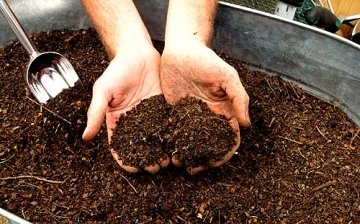
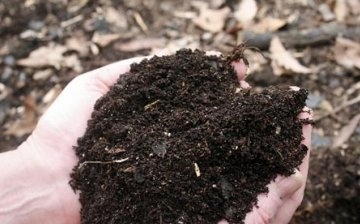
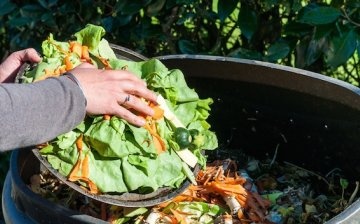
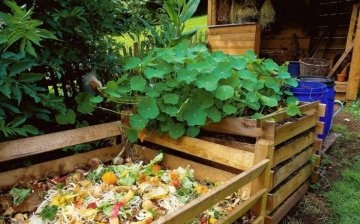
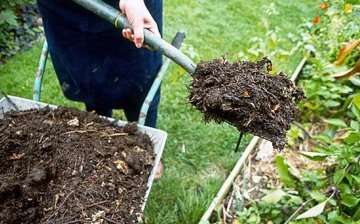







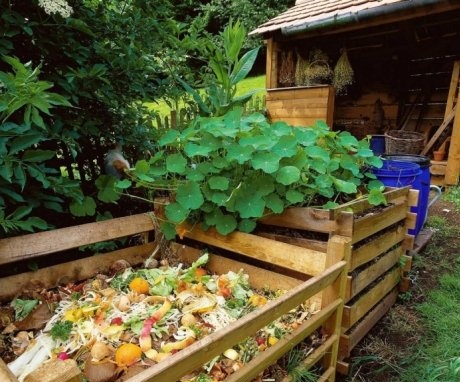

In order to prepare compost faster, the heap should not have a solid fence, but with gaps. In addition, the compost needs to be turned over from time to time. You can do it with a pitchfork. Thus, compost can be obtained in less than 2 months.
Compost is very useful for the earth, it fills it with all the necessary, useful substances, moreover, it attracts worms, and this cannot please anyone who achieves a good harvest.